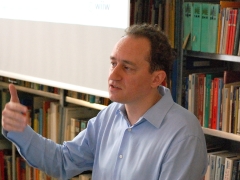Western CESEE countries in the ascendant
02 July 2015
At today’s press conference, Mario Holzner presented wiiw's new forecast for 22 CESEE countries. The underlying research report also analyses Austria’s relations with the region.
Favourable developments in the euro area; growth acceleration in NMS (3% in 2015); improvements also in the Western Balkans (but less dynamic); gloomy prospects in the CIS countries; overall CESEE growth acceleration acts as a demand stimulus for Austria
The outlook for GDP growth in the Central, East and Southeast Europe (CESEE) region remains divergent: we expect a gradual acceleration of GDP growth for most of the EU’s new Member States (NMS) starting this year. For 2015 growth is expected to increase to 3% on average, by 0.2 pp more as compared to last year. The recovery comes a year earlier than expected mainly based on favourable developments in the euro area. In the Western Balkans growth prospects will also improve over the whole forecast period 2015-2017, though slightly less dynamically. Growth performance in Belarus, Kazakhstan, Russia and Ukraine in 2015, however, will be dismal and partly worse than expected; the medium-term outlook for these countries is also fairly uncertain with considerable downside risks. Overall though, we should expect stronger CESEE growth to act as a demand stimulus for the Austrian economy. The NMS in particular are of increasing importance for Austria.
Austrian competitiveness unchallenged by CESEE; goods exports to NMS-5 expanded; CESEE also more important in terms of services exports; apart from tourism also business-related services exports prosper

Mario Holzner, wiiw Deputy Director
Austria faces only little risks of losing competitiveness to the CESEE countries. Over the longer run these countries have registered higher productivity increases but also much higher wage growth. While direct Austrian goods exports to Germany have lost some importance, exports to CESEE and especially the NMS-5 have gained shares in overall goods exports. Also in Austrian services exports, CESEE is an ever more important market, not only in terms of tourism but also due to business-related services exports. Regarding Austria’s total foreign demand, the CESEE growth stimulus was stronger than the German one in the past. However, over the forecast period this should equalise on account of the German recovery gaining momentum.
Integration process in Central Europe is advancing; Austria can profit from higher growth of neighbours; major EU economic policy challenge is saving in the corporate sector
Overall it can be noted that the integration process in Central Europe is still proceeding and that Austria has benefited from the higher growth rates of its eastern neighbours and will do so also in the future. A major economic policy challenge for the entire EU over the coming years is to substantially increase economic growth and fight mass unemployment. Especially the corporate sector has to be motivated to stop saving and to restart investment. Measures of recapitalisation and economic stimulus packages should lead to more consumer demand and subsequently to more investment of the private sector.
Press Releases
Related Presentations
- Western CESEE countries in the ascendant (press conference presentation in English)
- Aufwind im Westen Mittel-, Ost- und Südosteuropas: Wichtige Wachstumsimpulse für Österreich (press conference presentation in German)
